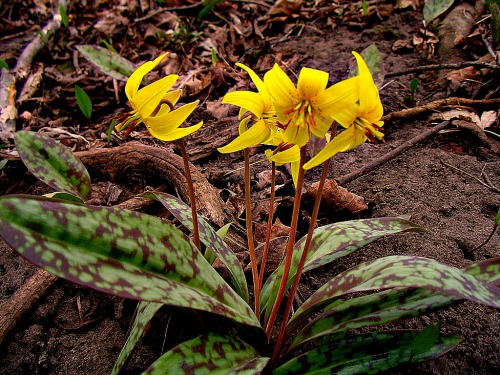Plant of the Month for March, 2015

(er-ih-THROH-nee-um a-mer-ih-KAY-num)
General Information:
Erythronium americanum is a great little plant for the spring, shade garden. It is native to most of Eastern North America and can found in many wooded areas in this region.
Nice mottled leaves with a yellow-orange tinged flower, Erythronium americanum is commonly called yellow adder’s tongue, yellow trout lily, yellow fawn lily and yellow dog-tooth violet. However it is not a violet.

Erythronium americanum; photo by Robert Pavlis
Corms of this plant will produce stolons that slowly spread to form large colonies. The corms can be quite deep making it difficult to transplant, but it can be grown from seed which can take 5 years to flower.
The bulbs (correctly called corms) of Erythronium americanum go deeper on their own if they are planted too shallow for the soil conditions. A lot of bulbs can do this using one of two mechanisms. Narcissus use contractile roots that grow down, get established and then pull the bulb lower. Tulips don't use contractile roots, but they do use something called ‘droppers’. A dropper is a stolon-like structure that grows down and then forms a new bulb at the tip of the dropper. Erythronium americanum use droppers, and do not have contractile roots.
By midsummer the plant goes under ground until next spring.
The main problem with this Erythronium is that it can be shy to flower and the reason for this is still unknown. In a typical colony you will find hundreds of single leaves that do not flower and only a few double leaves that do flower. I had a section of the garden that had a high percentage of flowering plants one year, and almost none the following year. So it is not just a case of maturity. Some claim that a single flowering plant will tend to divide into many smaller corms and therefore not flower the following year. This may be accelerated by a dry spring.
Some claim that extra fertilizer, more light or a very wet condition will produce more flowering plants. It could be that deeper corms flower better or that shallow corms flower better. Placing a rock under the corm at planting does not seem to work. Or it might be that some clones flower more than others. It is odd that these conditions are not better understood for a plant that is both beautiful and native to our woods.
In any event the plant makes a good addition to the garden, even if it is grown just for the leaves.
Life Cycle: perennial bulb
Height: 20 cm (8 in)
Bloom Time: spring
Natural Range: Eastern North America
Habitat: moist hummusy woods
Synonyms: none
Cultivation:
Light: part shade to full shade
Soil: moist, well drained
Water: moist in spring, dryer in summer
USDA Hardiness Zone: 3– 9
Propagation: seed, offsets
Seedex availability (ORG&HPS annual Seed Exchange): rarely
